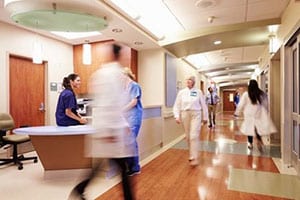In a hospital environment, safety and security are shared responsibilities that involve multiple stakeholders. These include the security department, healthcare workers, contractors, vendors, patients, and visitors. Each plays a crucial role in ensuring the well-being of everyone within the facility.
Here’s a detailed look at how each group contributes and some best practices for enhancing hospital security.
Security Department
Responsibilities: Ensuring a safe and secure facility including protecting people and property. This includes monitoring entrances, patrolling the premises, responding to incidents, and managing security systems.
- Implement regular training sessions on the latest security protocols and technologies.
- Become familiar with all legitimate hospital identification and spot fraudulent credentials.
- Use advanced surveillance systems to detect unusual activities.
- Establish a rapid response team for handling emergencies efficiently.
- Use visitor management systems to track non-employee movements within the hospital.
Educate contractors, vendors, patients and visitors about security protocols through informational pamphlets and signage. - Install access control systems that limit entry to sensitive areas.
Healthcare Workers
Healthcare workers interact constantly with patients, visitors, and family members, which can put them at risk. It’s essential for security measures to protect both the staff and the hospital’s assets while maintaining a positive patient experience.
Responsibilities: First and foremost, to provide excellent patient care. As the nurses, doctors, techs, etc are on the frontline they can also help maintain a safe environment.
- Conduct regular training on situational awareness and de-escalation techniques.
- Comply with hospital credential and dress code policies to help others know who is legitimate and may be attempting to impersonate staff.
- Use panic buttons and mobile apps that allow instant communication with security personnel.
- Encourage a buddy system during late-night shifts to enhance safety.
- Create a dedicated team to support healthcare workers experiencing aggressive or threatening behavior.
Contractors and Vendors
Responsibilities: Delivering goods and services, often while accessing various parts of the hospital, and adhering to all hospital procedures and policies.
- Implement strict vetting processes and background checks for all external personnel.
- Schedule deliveries during off-peak hours to minimize disruptions and enhance monitoring.
Patients and Visitors
Responsibilities: Following hospital rules and reporting any suspicious activities.
- Understand and follow all security protocols at the hospital.
- Report suspicious behavior.
Hospitals are public spaces intended for healing and support, which can make dealing with security issues more complex. Criminals may see hospitals as opportunities for theft or harm, underscoring the need for robust security systems with multiple layers of protection.
- Deploy a comprehensive security solution that includes video surveillance, intrusion detection, and access control.
- Regularly review and update security policies to address emerging threats.
- Conduct periodic security audits to identify and rectify vulnerabilities.
- Enhance safety with the use of proven technology.
The use of tools like Self-Expiring Visitor Badges and eVisitor Software can enhance safety and security by verifying identities, recording visitor information, and ensuring compliance with protocols. The color-changing feature of these badges helps prevent reuse and unauthorized access.
Ultimately, creating a culture of awareness and vigilance among all hospital staff is crucial for maintaining safety and security. By staying alert to potential security breaches and actively confronting suspicious behavior, everyone can contribute to a safer environment for patients, visitors, and staff alike.
- Launch regular security awareness campaigns to keep security top-of-mind for all employees.
- Develop a clear reporting protocol for suspicious activities and ensure it is widely communicated.
- Foster a collaborative environment where staff feel empowered to speak up about security concerns.
By taking steps like these, hospitals can create a secure environment that prioritizes the safety and well-being of everyone within their facilities.
To learn more about using a Visitor Management System to add and improve security at your hospital please call us 800-243-1969 to speak with a consultant and get badge sample or schedule a software demo.


